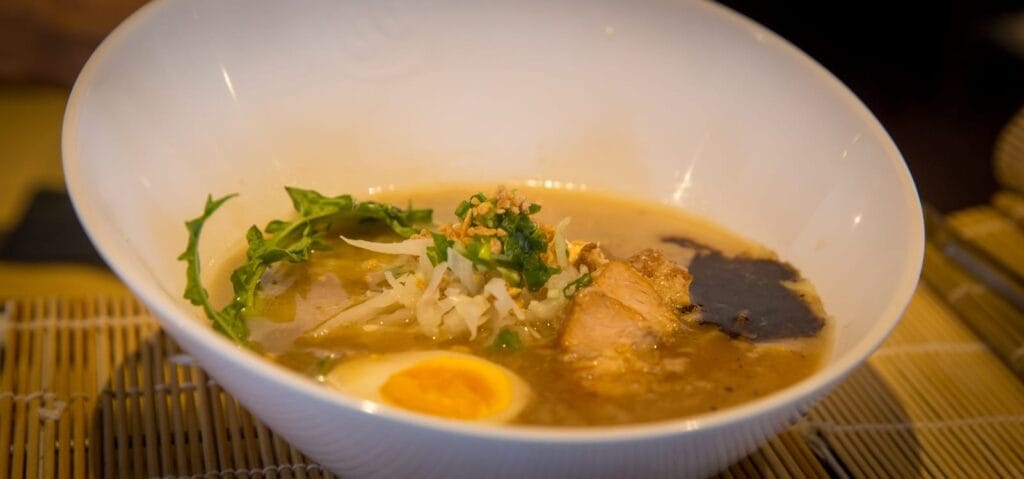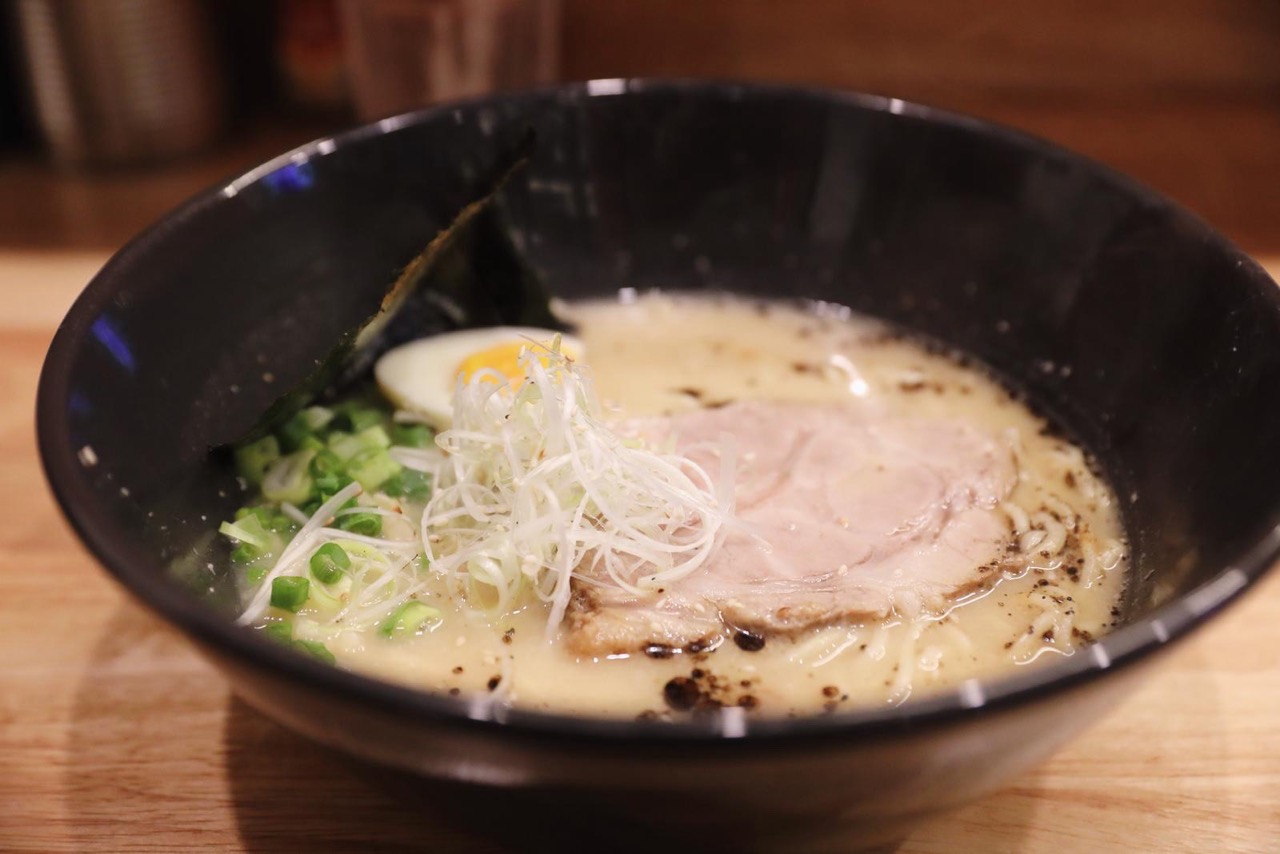Where To Find Fukuoka’s Best Bowls
If you’re craving authentic Hakata ramen in Fukuoka, you’re in for a treat.
While this iconic style originated in Kurume in 1937, today’s best bowls feature rich tonkotsu broth simmered for up to 18 hours, thin noodles, and traditional toppings like chashu pork and ajitama eggs.
I’d recommend starting at legendary spots like Hakuryuken or Akanoren Setchan, where generations of ramen masters have perfected their craft.
For a truly local experience, don’t miss Nakasu’s vibrant yatai food carts after 6 PM, where steam rises from bowls of soul-warming ramen under glowing lanterns.
There’s so much more to discover about this beloved regional specialty.
Origins of Hakata Style
A surprising twist in culinary history reveals that Hakata Ramen didn’t actually begin in Hakata at all.
Instead, I’ll take you back to 1937 in the bustling town of Kurume, where a creative food vendor named Miyamoto Tokio changed Japanese cuisine forever at his humble Nankin Senryo stall.
You might be wondering what sparked this culinary revolution.
Well, envision this: Tokio, experimenting at his stand near Nishitetsu Kurume Station, decided to combine pork broth with chicken bones and serve it with whisper-thin somen noodles.
What he created actually looked more like Nagasaki’s famous champon at first, but it would soon evolve into something entirely its own.
As the dish migrated to Hakata’s busy commercial district, I’ve found that necessity truly became the mother of invention.
The rushed pace of merchants and fishermen at Nagahama Fish Market demanded quick, satisfying meals.
That’s why those signature thin noodles weren’t just a style choice – they were a practical solution for faster cooking times, letting hungry workers get back to business without missing a beat.
Making the Perfect Tonkotsu Broth

While Hakata ramen’s origins reveal a fascinating evolution, the heart of this iconic dish lies in its rich, creamy tonkotsu broth.
I’ve spent countless hours perfecting this liquid gold, and I’ll tell you that the secret lies in three key elements: time, technique, and attention to detail.
| Step | Duration | Key Tips |
|---|---|---|
| Initial Boil | 10-15 min | Discard first water to remove impurities |
| Blanching | 30-45 min | Clean bones thoroughly after this step |
| Main Simmer | 6-18 hours | Maintain water level, skim regularly |
You’ll want to start with quality pork bones and trotters – they’re the foundation of that signature milky color and deep flavor we’re after.
I’ve found that searing the aromatics (onion, garlic, and ginger) beforehand adds an extra depth that’ll make your broth sing.
Don’t skip the initial blanching step; it’s essential for achieving that pristine white color that marks an authentic tonkotsu. As your broth simmers, you’ll notice it transforming from clear to creamy – that’s the collagen working its magic.
Keep an eye on the water level and skim regularly; think of it as nurturing a living thing that needs constant care.
Essential Toppings and Garnishes
Because every memorable bowl of Hakata ramen relies on its toppings, mastering the art of garnishing can elevate your dish from good to exceptional.
When you’re exploring Hakata’s ramen scene, you’ll want to pay special attention to the traditional heavy hitters: tender chashu pork, creamy ajitama eggs, and crisp green onions that provide that essential textural contrast.
I always recommend you start with these classic toppings before venturing into more adventurous territory.
You’ll find that menma (bamboo shoots) and nori add layers of umami that complement the rich tonkotsu broth, while pickled ginger cuts through the richness like a sharp knife through butter.
Don’t shy away from customizing your bowl – that’s part of the fun!
For an extra flavor boost, I suggest trying the spicy miso paste or a drizzle of garlic oil. And here’s a pro tip: those toasted sesame seeds aren’t just for show – they’re flavor bombs that’ll transform your ramen experience.
When in doubt, remember that the best toppings are those that enhance, rather than overwhelm, your broth’s character.
Top Ramen Shops in Fukuoka
Fukuoka’s five distinct ramen districts house some of Japan’s most celebrated Hakata ramen shops. If you’re craving authentic tonkotsu ramen, I’d steer you toward the historical heavyweights that have perfected their craft over decades.
Hakuryuken, established in 1952, serves what I consider the perfect introduction to Hakata-style ramen, with its clean soy sauce-based pork bone soup and signature flat noodles.
For an intensely rich experience, you can’t miss Akanoren Setchan, where they’ve been simmering pig parts for 16 hours since 1946 – a process that creates a broth so luxurious it’s practically liquid gold.
When you’re ready to explore beyond the classics, I recommend heading to Ramen Stadium in Canal City, where you’ll find an ever-changing lineup of Japan’s finest ramen artisans under one roof.
For a truly magical evening experience, though, nothing beats slurping noodles at one of Nakasu’s traditional yatai food carts, where the steam rising from your bowl mingles with the night air and the gentle chatter of fellow ramen enthusiasts.
The Noodle Making Process
The four essential ingredients in authentic Hakata ramen noodles – flour, water, kansui, and salt – come together through a precise process that I’ve mastered after years of practice.
I’ll share my techniques so you can create these distinctively thin, firm noodles that are the hallmark of Hakata-style ramen.
Start by combining your precisely measured ingredients in a mixing bowl, where the kansui solution works its magic to create that characteristic firmness and yellow hue.
Once you’ve mixed everything thoroughly, press the dough flat inside a resealable bag – this is where patience becomes your friend, as the dough needs a good 40-minute rest.
The real artistry comes in the cutting phase, where you’ll want to achieve those signature ultra-thin, straight noodles that perfectly complement the rich tonkotsu broth.
When it’s time to cook, remember that these delicate strands need just a brief, one-minute dance in boiling water.
I’ve learned that timing is everything – you’re aiming for that sweet spot between too firm and too soft, where the noodles retain their characteristic bite while harmonizing with the broth.
After mastering the perfect bowl of ramen indoors, I love experiencing how this iconic dish comes alive in Fukuoka’s bustling nighttime yatai scene.
When you visit between 6 PM and early morning, you’ll discover these intimate food stalls where locals and tourists squeeze shoulder-to-shoulder at counters seating just 8-10 people.
The atmosphere is electric – steam rising from bubbling pots, the sizzle of yakitori, and animated conversations filling the air.
You’re not just getting dinner; you’re stepping into a centuries-old tradition that’s survived everything from post-war bans to Olympic-era regulations.
| Yatai Experience | What to Expect |
|---|---|
| Seating | Intimate counter space, rubbing shoulders with strangers-turned-friends |
| Menu Variety | Classic ramen, oden, yakitori, plus surprising international fusion dishes |
| Best Times | 6 PM onwards, when the lanterns glow and the crowds start gathering |
While some locals have mixed feelings about these mobile kitchens, I can’t imagine Fukuoka without them.
The trade association’s efforts since the 1950s have preserved this vibrant culture, and today’s regulated environment guarantees you’ll enjoy not just great food but also an unforgettable slice of Japanese nightlife.
Local Tips for Eating
Every local ramen enthusiast will tell you that mastering Hakata’s dining etiquette is just as essential as appreciating its flavors.
I’ve learned that the art of enjoying a perfect bowl starts with understanding the kae-dama method – a brilliant system where you’ll receive smaller portions of noodles to prevent them from becoming soggy in that rich, creamy broth.
When you’re ready to engage, start with a respectful sip of the soup using your renge spoon before embracing the local custom of drinking directly from the bowl.
The steam rising from your ramen isn’t just for show – it’s carrying complex aromas that enhance your dining experience.
Here are my tried-and-true tips for eating like a Hakata native:
- Order your noodles extra firm (kata-men) for an authentic experience
- Use both hands to cup the bowl when drinking the broth, allowing the aroma to envelop you
- Save room for additional noodle servings (kae-dama) – they’re incredibly affordable
- Don’t hesitate to customize through the ordering machine, especially if you’re shy about speaking Japanese
Secret Ingredients and Techniques
Behind every exceptional bowl of Hakata ramen lies a complex symphony of ingredients and techniques that I’ve discovered through years of research and conversations with local chefs.
The heart of this legendary dish is the tonkotsu broth, where pork bones simmer for 8-12 hours until they surrender their rich essence, creating a creamy, soul-warming base that’s uniquely Hakata.
| Secret Element | Traditional Method | Modern Twist |
|---|---|---|
| Broth Base | Pork bones, 12hr simmer | Added clam juice boost |
| Aromatics | Basic ginger, garlic | Charred garlic oil (マー油) |
| Sauce Mix | Shoyu, mirin | Thai fish sauce blend |
You’ll find that the most guarded secrets often lie in unexpected combinations – I’ve seen masters splash Thai fish sauce into their tare (sauce base), while others swear by a touch of clam juice to amplify the broth’s umami.
The noodles themselves tell a story of precision, where kansui (alkaline water) transforms ordinary flour into those signature firm, straight strands that perfectly complement the rich soup.
Beyond Traditional Hakata Ramen
While Hakata ramen‘s iconic tonkotsu broth and thin noodles remain beloved staples, Japan’s diverse regions have spawned fascinating variations that push the boundaries of this classic dish.
From Hokkaido’s butter-topped miso ramen to Nagoya’s spicy Taiwan-inspired creation, I’ve discovered that regional interpretations offer compelling twists on the traditional formula.
You’ll find that each area’s unique ingredients and cultural influences shape these variations in delightful ways.
In Kitakata, they serve thick, wavy noodles that contrast beautifully with Hakata’s signature thin style, while Kurume’s intensely porky broth makes even Hakata’s rich tonkotsu seem mild by comparison.
- Sapporo’s miso-tonkotsu fusion exemplifies how regions blend local traditions with classic techniques
- Coastal areas like Onomichi incorporate fresh seafood from local waters, adding oceanic depth to their broths
- Kurume’s extra-rich tonkotsu predates and influenced Hakata’s famous version
- Taiwan ramen shows how international influences create exciting new interpretations
I’ve noticed that what makes these regional variations special isn’t just their unique ingredients – it’s how they reflect each area’s history, resources, and culinary pride while maintaining ramen’s soul-warming essence.







